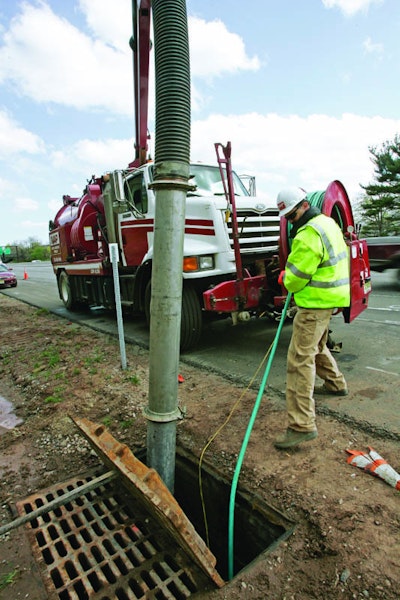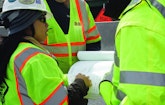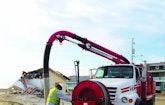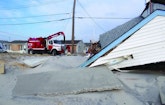
Interested in Waterblasting?
Get Waterblasting articles, news and videos right in your inbox! Sign up now.
Waterblasting + Get AlertsWhen Fred Choppy decided to sell his sewer cleaning and inspection company, North American Pipeline, last year, he didn’t have to look far for a buyer.
The 39-year-old business, based in Freehold, N.J., was operating primarily as a subcontractor in the commercial markets with some limited municipal work. Last year, Tom Mullen IV, an excavating contractor and old friend of the Choppy family, bought the firm.
Now, working with Fred’s son, Mullen is positioning the operation to expand beyond its original portfolio. He’s going after larger public-sector contracts and seeking to build a reputation all over the Garden State.
NAP is making its bid for growth at an especially propitious time. Last fall’s devastating Superstorm Sandy hit just as Mullen was getting ready to close on his purchase of the company. In the weeks and months since the storm paralyzed so much of the Northeast and wrought billions of dollars in damage, NAP has been busier than ever, taking on bigger and bigger projects.
It’s all part of Mullen’s long-term vision: to combine North American Pipeline with his excavation business and create a full-service underground utility contractor that can compete directly with larger firms in New Jersey and adjacent areas of New York and Pennsylvania, instead of just being a subcontractor. He’s even added “Services” to the company’s name.
“A major amount of the tri-state area infrastructure is past its useful life expectancy and will have to be serviced, repaired or replaced,” Mullen says.
Family tradition
Contracting is in Mullen’s blood. He’s the fourth generation in his family to be in the excavation and utility business in some manner. Back in high school he worked summers for his father, Thomas Mullen III, who owned an excavation business, and then full time for the company after graduating.
The younger Mullen moved on to the real estate development business, working for Renaissance Properties in the 1990s. After housing sales sagged in 2000, Renaissance owner Bob McDaid decided to branch out. Mullen and McDaid formed an excavating company to do utility pipe installations and repairs as well as site work for construction projects. With his own background so close to the industry, Mullen asked McDaid to put him in charge of the excavation business, and McDaid agreed.
The Choppy and Mullen families were friends. Mullen’s father’s excavating company had subcontracted sewer inspection and cleaning work to Choppy’s business, and now the younger Mullen did, too.
“NAP has always been around for as long as I can remember,” Mullen says. “All the time, I always said to Fred, ‘When you’re ready to sell, I would love the opportunity,” Mullen says.
That opportunity finally came in 2012 when Fred Choppy decided to retire. With McDaid’s assistance and the vision of combining the two businesses, Mullen jumped at the chance, closing the deal a week before Christmas 2012. Choppy’s son, Brad Choppy, came along with the company, and has the day-to-day responsibility of managing projects as vice president at NAP.
Public works expansion
Public works is a big part of Mullen’s plan for the business. Before he bought it, “Fred never really went after any public work unless it was through another contractor,” Mullen says.
He understands why. “There’s a huge amount of paperwork,” Mullen notes. “It’s almost as demanding, if not more demanding, as the actual physical work, which is the enjoyable part.”
Companies taking on public projects must get bonding. Office employees need to meet strict documentation rules for bonding and for bidding work, which requires training. And workers in the field need certification that they’ve been properly trained in safety standards required by public works projects.
But Mullen sees some big benefits in the arena. “There’s definitely a good-sized market,” he says of public works, and the need to repair and upgrade infrastructure is only growing.
And while there are hoops to jump through, he sees public work as potentially more secure. “You’re guaranteed to get paid when you do public work,” Mullen says. “You’re not chasing your money.”
Win or lose, bidding projects is getting the company’s name out, and lately he’s begun to win.
And the high profile of public work, he believes, may help market in the private sector, too — one reason that NAP has made sure its trucks are decorated in bold colors with engaging graphics. “If a private contractor is driving along the Parkway and they see all of our trucks out there, they’re going to have that kind of reassurance that you’re a company to reckon with and that’s capable of performing jobs,” Mullen says.
Building capacity
So, nearly from scratch, Mullen began building capacity to take on those projects through training, networking and marketing.
Safety training for National Association of Sewer Service Companies (NASSCO) certification is under way now. Employees have also been trained in the Hazardous Waste Operations and Emergency Response Standard (HAZWOPER).
“When you get into the public sector it’s imperative that your personnel are trained for occupational safety,” Mullen says.
And while there’s plenty of work, it doesn’t just come by itself. “Instead of just sitting there, waiting for the phone to ring, based on past relationships, we’re trying to grow our relationships to a bigger, broader customer base,” Mullen says.
NAP has joined the Utility Transportation Contractors Association (UTCA) and other regional groups to help get the word out about its capabilities, and also get the word in on work opportunities, such as information providers who track when communities are getting ready to bid work.
Another tool was putting the company on the Web in a big way. Mullen says that before the change in direction, NAP didn’t have or need a significant Web presence.
Cleaning up
All that work has begun to pay off. Recently the New Jersey Turnpike Authority embarked on a project to reline storm drain culverts on the Garden State Parkway — the main highway that hugs the New Jersey shoreline from Cape May to the New York state line in the far northeast corner of the state. The general contractors tapped North American to do the pre-cleaning prior to culvert installation.
“That will be our first, real official highway job,” Mullen says.
In the meantime though, Superstorm Sandy has made a lot of work for NAP, some of it months after the late October storm.
In mid-April, the company was hired by the community of Chadwick Beach, located on a spit of land in the Atlantic Ocean, to clean up storm drains that had been silted and covered over by the storm. For that they were again hired by another contractor who figured that North American might know the site better because it had cleaned storm drains there in the past.
“It was so silted over they really didn’t have a good idea where the lines run,” Mullen explains.
That wasn’t the first Sandy job. In the weeks after the storm, North American was called in by the borough of Deal, just north of Asbury Park, to clean up a sewage pumping station that had been overwhelmed by ocean waves whipped up by Sandy.
The building is 30 by 30 feet and three stories tall. Waves had roared over the building with such force that they destroyed the roof and flooded out a backup generator on site.
Choppy, who headed up the operation, says they could see the sun bright as day through where the roof had once been. “Everything was all shut down. It had knocked down the walls of the bathroom.”
An office on the top floor – the building’s entry floor – was all but demolished. “The computer, the desk, everything was destroyed,” Choppy says.
Cleaning required vacuuming out the pit at the bottom level of the structure, while other debris was too big even for the vacuum truck and had to be hauled out.
Fifteen tons
At another sewage station that NAP was called to clean, in Lake Como, crews found a door ripped off, an exhaust fan destroyed by a log that was stuck in it, even a piece of a handicapped-parking sign from the community’s boardwalk that had been ripped up by waves and washed over to the facility.
“We had to clean that entire facility,” says Choppy. “There was 15 tons of material in there, from sewage to whatever else.”
While North American was experienced in sewer and storm cleaning, this was something else, he says, both because of the amount of sand and the amount of debris – everything from cans and bottles to logs and more. “We found a car one time,” Choppy says.
Eyeing new areas
Looking ahead, Mullen is making plans to expand into pipeline rehabilitation using slip lining and other forms of trenchless pipe repair. The company has two CUES sewer cameras and their support vans (one a Ford, one a Chevy). It also has three CUES mini-cameras and is looking at upgrades. NAP recently acquired a camera that can go into pipe as small as 1.5 inches, and also has a built-in locator.
Three Jet-Vac combination trucks along with air-testing gear, mandrels and vacuum testing equipment add to the resources available.
Mullen is also watching the many new technologies proliferating in the market.
Eventually he sees the excavation company and the pipeline services business coming under the same umbrella, “to become a one-stop shop offering full pipeline service,” says Mullen. “Hopefully being under one roof will give us a competitive edge.”
North American Pipeline may be four decades old, but that’s still young. Mullen points out, however, that it has deep experience even as it’s being, in some respects, reborn.
And it’s got another key asset, he adds: “Now what’s here is a massive amount of drive.”











